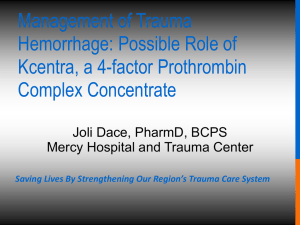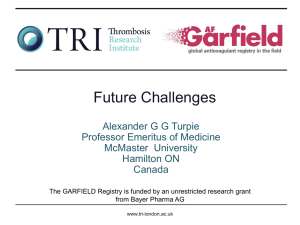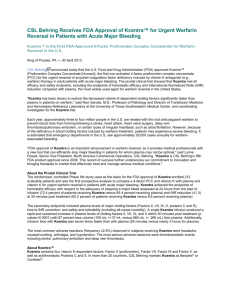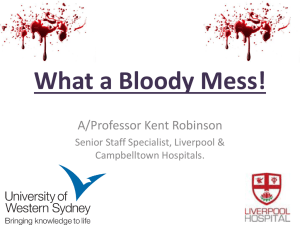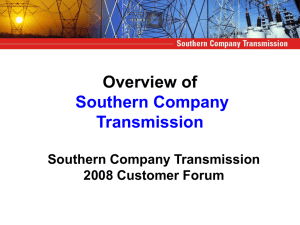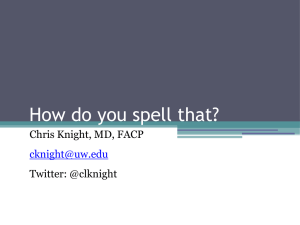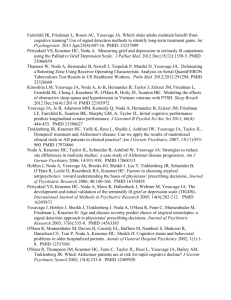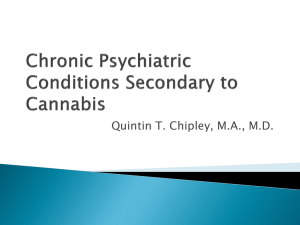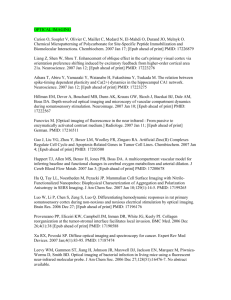Kcentra In-Service – Full
advertisement
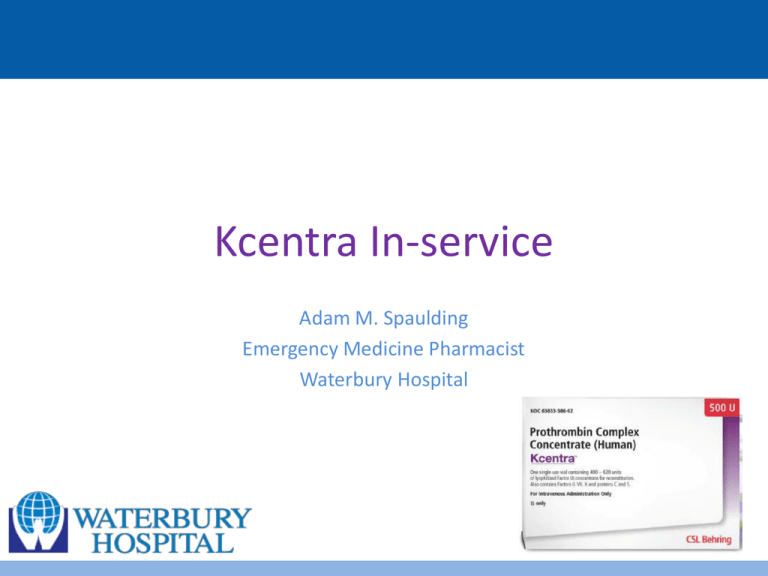
Kcentra In-service Adam M. Spaulding Emergency Medicine Pharmacist Waterbury Hospital Prothrombin Complex Concentrates Contain Vitamin K-dependent clotting factors Made from pooled human plasma Activated: Novoseven, FEIBA Inactivated: Profilnine, Bebulin, Kcentra 4-F PCC (Kcentra) Contains clotting factors: II, VII, IX, X – All non-activated factors – Contains heparin and ATIII to keep non-activated Contains proteins C and S and human albumin – Mimics natural milieu – Confers less risk of thrombosis Inactive ingredients: sodium citrate, sodium chloride Kcentra [package insert]. 2013 Clinical Use FDA indication: – Emergent reversal of bleeding due to Vitamin K Antagonists – Emergent reversal of anticoagulation prior to emergent procedures Un-labeled indications: – Emergent reversal of direct Xa inhibitors (+/- DTIs) – Bloodless surgery Kcentra [package insert]. 2013 USA Guyatt, et al. CHEST 2012. PMID: 22315257 Spahn et al. Critical Care 2013. PMID: 23601765 Europe Dosing VKA reversal: Based on INR and weight (kg) – INR 2-4: 25units/kg – INR 4.1-6: 35units/kg – INR >6: 50units/kg Direct Xa inhibitors: Empirically weight-based – Clinical presentation/history: 25-50units/kg >1 dose not studied, not recommended and not approved at WH Kcentra [package insert]. 2013 Spahn et al. Critical Care 2013. PMID: 23601765 Administration Europe: given bedside via syringe (each vial pushed slowly over 2-3 minutes) USA (and WH): Contents pooled in a bag and infused at 8.4mL/min (500mL/hr) Follow by 50-100mL NS at same rate MUST BE GIVEN WITH VITAMIN K UK transfusion guidelines: Beriplex. JPAC. 2009 Kcentra [package insert]. 2013 “Advantages” over FFP: Practical and Theoretical • No checking blood groups or cross-matching • No waiting for blood to thaw • Less risk for viral transmission • No risk of TRALI Babilonia, et al. Thrombosis Journal 2014. PMID: 24742134 • Less complications from volume overload • ≤200mL vs 800-1000mL • Reduce transfusion reactions? • Much quicker reversal of INR PMID: 23935011 PMID: 23935011 PMID: 23935011 Safety Hanke, et al. Br J Anaest. 2013. PMID: 23335567 PCC FOR NOACS (HUMAN STUDIES) Author, Year N Study Design Findings Erenberg, 2011 12 • Dabigatran or rivaroxaban po x 2.5 d • Treated with 3F-PCC bolus iv • Measured PT and ETP over 24 hours Findings • PCC reversed PT, ETP in rivaroxaban treated patients • PCC did not reverse dabigatran Marlu, 2012 10 Men Dabigatran or rivaroxaban po x1 • Collected blood samples • Treated blood (3-F PCC, rFVIIa, aPCC) Findings • Dabigatran – rFVIIa most effective • Rivaroxaban - PCC most effective Khoo, 2013 8 • Dabigatran+aPCC (FEIBA) • Blood treated with aPCC Findings • aPCC reversed dabigatran Dinklaar, 2013 9 • Rivaroxaban+ 3F-PCC • PCC added to rivaroxaban-treated samples • Coagulation assays performed Findings • PCC normalized thrombin generation • Did not normalize PT w/ initial dose • Dose of PCC required depended on type of assay Korber, 2013 10 • Rivaroxaban + PCC/rFVIIa • Blood samples treated with rivaroxaban • Added PCC and rVIIa • Performed clotting assays Findings • PCC had no effect on clotting tests • rVIIa reversed PT and clotting factor time Dabigatran • Reversed with aPCC in 2/2 studies Lazo-Langner, et al. Critical Care 2013. PMID: 23806169 Rivaroxaban • Reversed with PCC in 3/4 studies PCC for NOACs: Limitations in the literature Many more animal studies than human studies Human clotting factors behave differently in non-humans Small “N” Wide variability in study design Different doses Different species Different outcomes (coagulation assays, bleeding time, blood loss) Healthy volunteers Reversal agents merely added to blood samples Extrapolation to bleeding patients? Outcomes include normalization of clotting tests as proxy for bleeding cessation** Our protocol Restrictions for use at Waterbury Hospital Kcentra Restrictions Inclusion Criteria: Treatment of life-threatening bleeding or major bleeding associated with hemodynamic instability in patients taking warfarin, rivaroxaban or apixaban (including those who present with intracranial hemorrhage and declining neurologic status) Rapid correction of INR in patients receiving warfarin and who required immediate reversal for life-sustaining procedures (anticipated need within 8 hours) Exclusion Criteria: Known history of heparin-induced thrombocytopenia Disseminated intravascular coagulation is suspected Able to tolerate FFP volume and slower time of onset Bleeding due to dabigatran (advise the physician over the phone) Bleeding in the absence of an anticoagulant Our Protocol Ordering and dosing Preparation Administration Ordering/Dosing Limited to ER, Neurology, Trauma surgery and ICU – STAT call to ED Pharmacist/Pharmacy Doses will be rounded to the nearest 500 factor IX units by the verifying pharmacist – Use the rounding cheat sheet – Order must be re-entered Pharmacist verifies appropriate indication, dose and that a concurrent order for Vitamin K exists Only one dose of Kcentra can be ordered/patient Dosing Cheat Sheet Storage and Preparation Kcentra Kit Contents (1) Contents list sheet (10) Kcentra 500unit vials (10) Manufacturer supplied 20mL diluents (SWFI) (10) Mix2Vial transfer devices (5) alcohol swabs (4) 60mL syringes (1) Intravia 250mL empty bag (1) Premade label • • • • Nominal potency will be used to calculate # of vials Vials will be reconstituted with Mix2Vial transfer set provided Multiple syringes will be pooled into a 250mL Intravia container LOT numbers will need to be documented in the medical record* Administration Administer within 4 hours of reconstitution Dedicated line required for administration – 2 separate lines preferable (one for Vitamin K) Administered as an infusion @ 500ml/hr After infusion, the line needs to be flushed with NS – Replace Kcentra with 50-100cc bag NS and run at same rate Need f/u INR 30 minutes after infusion Cost $1.34 per unit ~$670 per vial (~500 units) $6700 for 5,000 unit dose (max dose) Unlike Genentech for alteplase, Kcentra is not reimbursed/replaced if the product is mixed, but not used CMS offers NTAP program for Kcentra If total costs of inpatient stay exceed the MS-DRG payment amount, NTAP attempts to pay the difference Payment is NOT based on the dosage of Kcentra administered Additional payments through NTAP are capped at $1,587.50 References 1. 2. 3. 4. 5. 6. 7. 8. Kcentra [package insert]. King of Prussia, PA: CSL Behring; 2013. Guyatt GH, Aki EA, Crowther M, et al. Executive Summary: Antithrombotic therapy and prevention of thrombosis, 9th ed: American College of Chest Physicians Evidence-Based Clinical Practice Guidelines. Chest 2012; 141: 7S-47S. PMID: 22315257 Spahn DR, Bouillon B, Cerny V, et al. Management of bleeding and coagulopathy following major trauma: an updated European guidelines. Crit Care 2013; 17(2):R76. PMID: 23601765 Joint United Kingdom (UK) Blood Transfusion and Tissue Transplantation Services Professional Advisory Committee (JPAC). UK Transfusion Guidelines: Beriplex. 2009. URL: http://www.transfusionguidelines.org.uk/document-library/documents/prothrombin-complexconcentrate-beriplex-oxford-radcliffe-hospitals-2009 Babilonia K, Trujillo T. The role of prothrombin complex concentrates in reversal of target specific anticoagulants. Thrombosis Journal 2014;12:8. PMID: 24742134 Sarode R, Milling TJ, Refaai MA, et al. Efficacy and safety of a 4-factor prothrombin complex concentrate in patients on vitamin K antagonists presenting with major bleeding: a randomized, plasma-controlled, phase IIIb study. Circulation 2013; 128:1234-1243. PMID: 23935011 Hanke AA, Joch C, and Gorlinger K. Long-term safety and efficacy of a pasteurized nanofiltrated prothrombin complex concentrate (Beriplex® P/N): a pharmacovigilance study. Br J Anaest. 2013; 1-9. PMID: 23335567 Lazo-Langner A, Lang ES, Douketis J. Clinical review: clinical management of new oral anticoagulants: a structured review with emphasis on the reversal of bleeding complications. Critical Care 2013; 17:230. PMID: 23806169 Questions?
